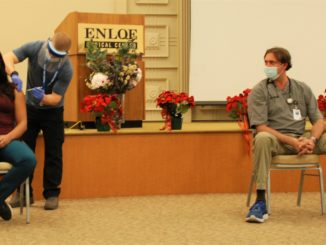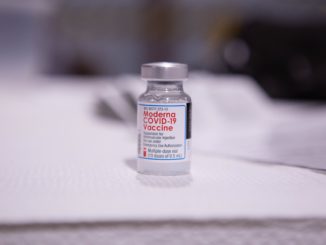
Coronavirus. That one word has gone viral the past few weeks. It has dominated headlines and triggered fear, evoking images of quarantined cruise ships, makeshift treatment centers and mask-wearing populations.
The disease broke out in late December in Wuhan, China—half a world away. Yet, when Humboldt County announced its first case last Thursday (Feb. 20), suddenly the threat seemed close to home.
This new (or “novel”) coronavirus, Covid-19, is in the same family as the SARS and MERS viruses, which spread widely in 2002-03 and 2014-15, respectively. Covid-19 is more contagious, according to a study of 72,000 cases by Chinese scientists, and that communicability already has led to more deaths than its viral relatives.
Though restrictions on media in China have limited the release of reliable statistics, the World Health Organization and U.S. Centers for Disease Control and Prevention estimate Covid-19 has killed 2,250 and infected 76,800 worldwide. SARS, by contrast, sickened just over 8,000 in totality and killed 774, while MERS has affected around 2,500 and killed 858.
At the time of the Humboldt County report, California was home to nine cases of the coronavirus. Including travelers bringing the virus home, the CDC had logged three dozen national cases as of last Friday (Feb. 21). This week, San Francisco declared a state of emergency in response to coronavirus internationally despite having no reported cases; Santa Clara County already had taken that step to boost preparedness.
In the grand scheme of health concerns, should we in the North State worry?
“Firstly, there is not a pandemic worldwide or in the U.S.,” said Dr. Roy Bishop, a family medicine physician who runs Argyll Medical Group in Chico. “There are a small number of [domestic] cases—all have been imported or [came about through] contacts with people who have flown back.
“The overall danger at the moment is not high,” he added by phone last Friday. “What the World Health Organization is concerned about is [we] could get an epidemic taking off in other countries on a Chinese level; that technically would be a pandemic, a worldwide epidemic. But right now, we don’t have that.”
What we in the region do have is an influenza outbreak.
The Butte County Public Health Department recently alerted hospitals and physicians to reports of increased flu activity in the county. The department doesn’t have hard data, spokeswoman Lisa Almaguer said by phone, as it receives only voluntary reporting of flu cases from health care providers—BCPH records flu deaths, of which just one has occurred in the county in five years. Statewide, the California Department of Public Health has reported 328 deaths thus far this flu season—more than double the number recorded this time last year—with 80 percent of those coming since Jan. 1.
“People think because it’s February, coming on to March, that flu season is over,” Bishop said. “Actually, it isn’t.”
Bishop said he has diagnosed Influenza A and Influenza B this year; several patients have been hospitalized at Enloe Medical Center due to the flu.
“What most of those people have in common is they have not had an influenza vaccination,” he added.
Almaguer said Public Health clinics have flu vaccines but suggested pharmacies and primary care physicians might have greater supplies. The department recommends immunization for anyone older than 6 months who doesn’t have a condition (such as vaccine allergy) precluding them from vaccination—particularly children under 5, pregnant women, seniors and adults with respiratory issues.
Other precautionary measures include frequent hand-washing; not touching eyes and nose with unwashed hands; staying home when feeling ill, unless absolutely unavoidable; and, when ill, wearing an N95 mask.
“In the whole United States, the place with the most N95 masks out among the public is probably Chico,” Bishop noted, “because we were all taught to get them for the Camp Fire.”
Indeed, whether coronavirus or influenza, potentially lethal respiratory viruses merit comparable precautions.
Covid-19 symptoms include fever, cough and shortness of breath; these can present as quickly as two days after exposure or as long as 14 days, which is why the federal government has quarantined incoming passengers for the latter time period. County public health officials take their cues from the CDC.
“Our top priority is preventing the spread, limiting the spread, ultimately to protect the health of the county,” Almaguer said. “We stand ready. I don’t think we’ll be surprised if we do see a confirmed case [of novel coronavirus] at some point; in the same breath, we may be successful and not receive a returning traveler at a high risk level.”
Should BCPH receive report of a Covid-19 case, the department has protocols in place for monitoring and, if necessary, quarantining the patient.
“People are concerned, and they have a right to be concerned,” Almaguer added. “It’s new, and we don’t know everything about it.”
Mystery and conspiracies have surrounded the cause of this novel coronavirus in China. An international group of public health scientists published a statement in the Lancet medical journal last Wednesday (Feb. 19) refuting “rumours and misinformation about its origins.” U.S. Sen. Tom Cotton (R-Ark.) was among the most public promoters of a connection between the outbreak and a lab—the Wuhan Institute of Virology—where researchers study coronaviruses in bats.
Still, despite the furor, Covid-19 is not the biggest local woe. In addition to citing flu, Bishop pointed to sepsis as more significant.
Bacterial sepsis—a life-threatening reaction to an existing infection, in this instance from a bacteria—“is often forgotten and underreported,” he said. Ill patients who spike fevers and suffer decreases in blood pressure and consciousness also could have sepsis.
“As far as Butte County goes, coronavirus is way down the list of risks right now,” Bishop added. “It’s not to say we can’t have an epidemic; I suppose the potential is there if we allow it to get established, get going, get spreading sideways in the population. That would be bad news.”



